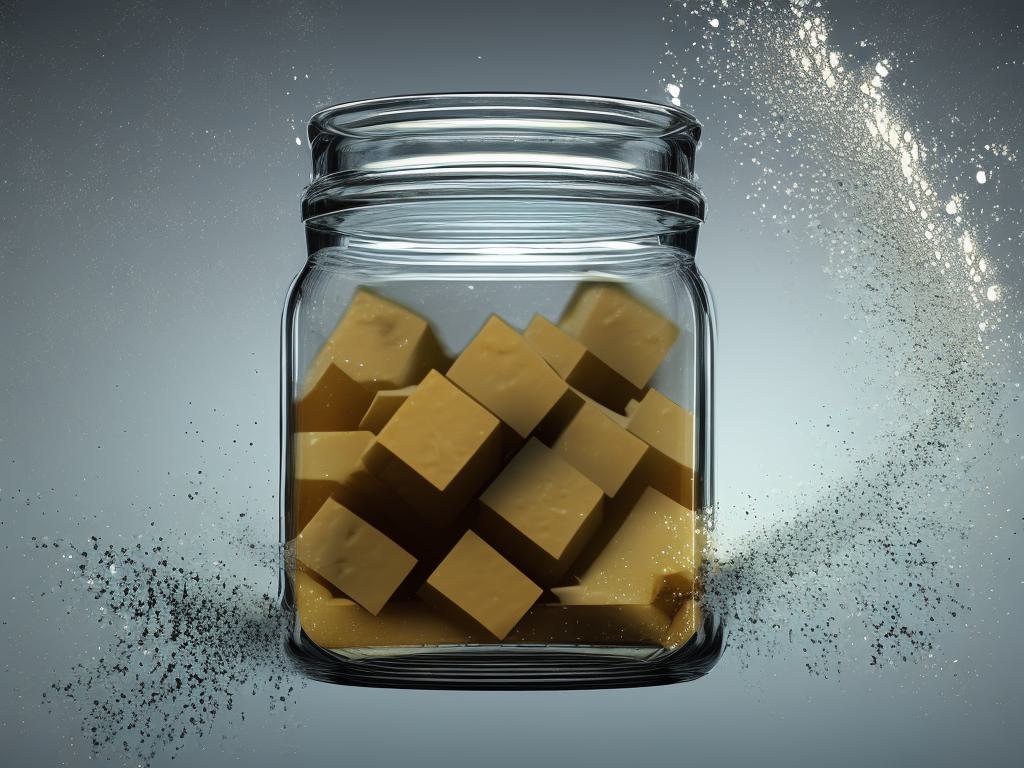If you’re looking for a healthy and delicious food to add to your diet, fermented tofu is an excellent choice.
This versatile ingredient can be used in a variety of dishes, from stir-fries to salads, and it’s packed with nutrients that are essential for good health.
One of the most interesting things about tofu is that it’s made through a process of fermentation.
In this article, we’ll take a closer look at how tofu is fermented and explore some of its many health benefits.

The Basics of Fermented Tofu
Tofu is made by coagulating soy milk and then pressing the resulting curds into blocks.
But before the coagulation process can begin, the soy milk must first be fermented.
The Fermentation Process
Fermentation is a natural process that occurs when microorganisms like bacteria or yeast break down organic matter.
In the case of tofu, the soy milk is inoculated with specific strains of bacteria that convert the sugars in the milk into lactic acid.
This creates a tangy flavour and helps to thicken the milk, making it easier to coagulate later on.
The Bacteria Used in Fermented Tofu
There are several different types of bacteria that can be used to ferment soy milk, each of which produces a slightly different flavour profile.
Some of the most common bacteria used in tofu fermentation include:
- Lactobacillus delbrueckii subsp.
- bulgaricus
- Streptococcus thermophilus
- Bifidobacterium bifidum
- Lactococcus lactis
The Coagulation Process
Once the soy milk has been fermented, it’s ready to be coagulated and turned into tofu.
The coagulation process involves adding a substance like calcium sulphate or nigari (a mineral-rich coagulant derived from seawater) to the fermented soy milk.
This causes the proteins in the milk to clump together and form curds.
The Pressing Process
The curds are then pressed to remove excess liquid, resulting in a firm block of tofu that can be sliced, diced, or crumbled as needed.
Fermentation is a crucial step in the tofu-making process, as it not only adds flavour but also helps to thicken the soy milk for easier coagulation.
The type of bacteria used in tofu fermentation can have a significant impact on the final flavour of the tofu.
Pressing the curds is an essential step in creating firm tofu that can hold its shape when cooked.
Tofu Press with Cheesecloth ⇒ SHOP HERE NOW
The Health Benefits of Fermented Tofu
Fermentation is an ancient technique that’s been used for centuries to preserve food and enhance its nutritional value.
And when it comes to tofu, fermentation offers some significant health benefits that you won’t find in regular unfermented soy products.
Improved Digestion and Nutrient Absorption
The lactic acid produced during fermentation helps break down the complex sugars in soy milk, making it easier for your body to digest.
This can reduce bloating, gas, and other digestive issues that can arise from eating unfermented soy products.
Fermentation also increases the bioavailability of certain nutrients in soy, including iron, calcium, and zinc.
This means that your body can absorb these essential minerals more easily when you eat fermented tofu.
- Fermentation can improve digestion and increase nutrient absorption in soy products.
Lowered Cholesterol and Better Immune Function
Some studies have shown that consuming fermented soy products like tofu can help to lower LDL (bad) cholesterol levels in the blood.
This may be due to the presence of compounds called isoflavones, which have been shown to have cholesterol-lowering effects.
Fermented foods are rich in probiotics, which are beneficial bacteria that live in your gut and play a key role in immune function.
Eating fermented tofu can help boost your overall immunity and protect you against infections and illnesses.
- Fermented tofu can help lower cholesterol levels and improve immune function.

Other Health Benefits of Fermented Tofu
In addition to the benefits listed above, fermented tofu may also have other health benefits.
For example, some studies have suggested that fermented soy products may help reduce the risk of certain types of cancer, including breast and prostate cancer.
Fermented tofu is also a good source of protein, making it a great addition to a vegetarian or vegan diet.
How to Incorporate Fermented Tofu into Your Diet
If you’re interested in trying fermented tofu, there are many ways to incorporate it into your diet.
You can use it as a meat substitute in stir-fries, soups, and stews, or crumble it over salads for added protein.
You can also find fermented tofu in many Asian grocery stores, where it may be sold under the name stinky tofu.
- Fermented tofu can be used as a meat substitute in many dishes and can be found in Asian grocery stores.
Overall, fermented tofu is a nutritious and delicious food that can offer many health benefits.
Whether you’re looking to improve your digestion, boost your immune system, or simply add more protein to your diet, fermented tofu is definitely worth trying.
The Different Types of Fermented Tofu
When it comes to fermented tofu, there are many different types to choose from.
Each variety has its own unique flavour and texture, making it a versatile ingredient in many dishes.
Here are some of the most popular types of fermented tofu:

White Fermented Tofu
White fermented tofu is a mild-flavoured tofu that has been fermented in brine for several months.
It has a soft, creamy texture and is often used as a condiment or seasoning.
This type of tofu is a popular ingredient in many Chinese dishes, including hot pot and stir-fries.
Red Fermented Tofu
Also known as Chinese cheese, red fermented tofu is made by fermenting tofu in a mixture of rice wine, vinegar, and red yeast rice.
It has a strong, pungent flavour and is often used to add depth to soups and stews.
This type of tofu is a staple in many Chinese households and is also popular in other Asian countries.
Did you know that red fermented tofu is often used as a meat substitute in vegetarian dishes?
Pickled Fermented Tofu
Pickled fermented tofu is made by soaking tofu in vinegar and salt before fermenting it.
This gives it a tangy, sour flavour that is perfect for snacking or as an appetiser.
It’s also a popular ingredient in many Chinese and Taiwanese dishes, including stinky tofu.
Stinky tofu is a popular street food in Taiwan that is made by deep-frying pickled fermented tofu.
Vegan Cheese
Some companies are now making vegan cheeses from fermented tofu.
These products have a similar texture and flavour to traditional dairy cheese but are made entirely from plant-based ingredients.
They are a great option for those who are lactose intolerant or follow a vegan diet.
Did you know that fermented tofu is also a good source of protein and calcium?
White Fermented Tofu:
- Mild-flavoured tofu that’s been fermented in brine for several months.
- Soft, creamy texture.
- Often used as a condiment or seasoning.
Red Fermented Tofu:
- Also known as Chinese cheese.
- Fermented in a mixture of rice wine, vinegar, and red yeast rice.
- Strong, pungent flavour.
- Often used to add depth to soups and stews.
Pickled Fermented Tofu:
- Soaked in vinegar and salt before being fermented.
- Tangy, sour flavour.
- Often served as a snack or appetiser.
- Made from fermented tofu.
- Similar texture and flavour to traditional dairy cheese.
- Plant-based ingredients.
How To Do Fermented Tofu (Recipe)
Fermented tofu, also known as “stinky tofu,” is a popular Chinese dish that is known for its unique aroma and flavour.
This recipe will guide you through the process of making your own fermented tofu at home. The fermentation process will result in tofu with a strong, savoury taste and a slightly pungent aroma.
Let’s get started!
Ingredients:
- 1 block of firm tofu
- 1 teaspoon rice wine or cooking wine
- 1 teaspoon salt
- 1/4 teaspoon dried chilli flakes (optional)
- Distilled water
- Fermentation vessel (glass jar with a tight-fitting lid)
Instructions:
1 – Prepare the tofu:
- Remove the tofu from its packaging and gently press it between paper towels or a clean kitchen towel to remove excess moisture. Cut the tofu into small, bite-sized cubes.
2 – Create the brine solution:
- In a mixing bowl, combine 1 teaspoon of salt with 1 teaspoon of rice wine or cooking wine. Mix well until the salt dissolves. If desired, add 1/4 teaspoon of dried chilli flakes to the mixture for a spicy kick.
3 – Place the tofu in the fermentation vessel:
- Arrange the tofu cubes in the fermentation vessel, ensuring they are tightly packed together. Leave a small amount of space at the top, as the tofu will release liquid during the fermentation process.
4 – Pour the brine solution:
- Slowly pour the prepared brine solution into the fermentation vessel, making sure it covers the tofu completely. Leave about half an inch of space at the top to prevent overflow during fermentation.
5 – Seal the fermentation vessel:
- Secure the lid tightly on the fermentation vessel to create an airtight seal. This is crucial to prevent contamination and allow for proper fermentation.
6 – Fermentation:
- Place the sealed fermentation vessel in a cool and dark area, away from direct sunlight. The ideal temperature for fermentation is around 77°F to 86°F (25°C to 30°C). Allow the tofu to ferment for a minimum of 2 days to a maximum of 1 week, depending on your preference. The longer the fermentation, the stronger the flavour will be.
7 – Check the progress:
- After 2 days, you can start checking the tofu for its fermentation progress. Open the fermentation vessel and inspect the tofu for any signs of mould or off-putting odours. A pleasant, slightly pungent aroma is normal. If you notice any signs of spoilage, discard the tofu and start over.
8 – Storage:
- Once you’re satisfied with the fermentation, transfer the fermented tofu to a clean container and store it in the refrigerator. It can be consumed immediately or left to age further for more pronounced flavours.
9 – Serving suggestions:
- Fermented tofu can be enjoyed in various ways. It can be steamed, pan-fried, or added to stir-fries, soups, and hot pots. You can also enjoy it as a condiment or topping for rice or noodles.
Note: Remember to practise good hygiene throughout the process to prevent contamination. Cleanliness is key to successful fermentation.
Enjoy your homemade fermented tofu, and savour the unique flavours that it offers!
How to Use Fermented Tofu in Your Cooking

Fermented tofu is a versatile ingredient that can be used in a variety of dishes, both savoury and sweet.
Here are some ideas to get you started:
Salads and Sandwiches
Add crumbled white fermented tofu to salads or sandwiches for an extra boost of protein and flavour.
Soups, Stews, and Sauces
Use red fermented tofu to add depth to soups, stews, and sauces.
Vegan Cheese Sauce
Make a vegan cheese sauce by blending together white fermented tofu, nutritional yeast, and your favourite seasonings.
Did you know that fermented tofu is a popular ingredient in vegan and vegetarian cooking? It can be used to add a cheesy flavour to dishes without using dairy products.
Rice and Noodles
Crumble pickled fermented tofu over rice or noodles for a tangy, savoury topping.
- Fun fact: Fermented tofu is a staple ingredient in many Asian cuisines, particularly in China and Taiwan.
Replacing Dairy Cheese
Use fermented tofu in place of dairy cheese in your favourite recipes, like lasagna or pizza
- Another benefit of using fermented tofu as a cheese substitute is that it is lower in fat and calories than dairy cheese.
The Risks and Side Effects of Fermented Tofu
While fermented tofu is generally considered safe for most people to eat, there are some potential risks and side effects to be aware of.
Sodium Levels
One concern is the high levels of sodium that can be present in some types of fermented tofu.
If you’re watching your salt intake, be sure to read labels carefully and choose low-sodium options whenever possible.
Phytoestrogens
Another issue is the presence of certain compounds in soy products called phytoestrogens.
These compounds have been shown to mimic the effects of oestrogen in the body, which can be problematic for some individuals.
If you have a history of breast cancer or other hormone-sensitive conditions, it’s best to talk to your doctor before adding fermented tofu to your diet.
Did you know that phytoestrogens can also interfere with thyroid function in some people?
Digestive Discomfort
Finally, some people may experience digestive discomfort when eating fermented foods like tofu.
This is usually due to the increased levels of probiotics and fibre in these foods, which can take some time for your gut to adjust to.
If you experience bloating, gas, or other issues after eating fermented tofu, try starting with small amounts and gradually increasing your intake over time.
Did you know that fermented tofu can actually help improve digestion in some people by promoting the growth of healthy gut bacteria?
In Conclusion
Fermented tofu is a delicious and nutritious food that offers many health benefits.
Whether you’re looking to improve your digestion, boost your immunity, or simply add more plant-based protein to your diet, this versatile ingredient is definitely worth trying.
Understanding how tofu is fermented and exploring its many different varieties and uses, you can discover new ways to incorporate this healthy food into your meals and enjoy all the benefits it has to offer.
FAQs About Tofu Fermentation
Q: What is fermented tofu called?
A: Fermented tofu is commonly known as “stinky tofu” due to its unique aroma.
Q: Is fermented tofu good for you?
A: Fermented tofu is a good source of protein and contains beneficial probiotics. However, its high sodium content should be considered for those on a low-sodium diet.
Q: What is the difference between fermented tofu and tofu?
A: The main difference is the fermentation process. Regular tofu is made from soy milk, while fermented tofu undergoes a fermentation process, resulting in a distinct flavor and aroma.
Q: How much alcohol is in fermented tofu?
A: The alcohol content in fermented tofu is generally low, as most of the alcohol is produced during the fermentation process and is released.
Q: Is store-bought tofu fermented?
A: Store-bought tofu is typically not fermented unless specifically labeled as such. Most commercial tofu varieties are made from coagulated soy milk without undergoing fermentation.
Q: What is fermented tofu called in Chinese?
A: Fermented tofu is called “chou doufu” in Chinese.
Q: Is there a downside to eating tofu?
A: While tofu is generally considered a healthy food, some individuals may have soy allergies or sensitivities. Additionally, consuming excessive amounts of tofu may affect thyroid function due to its goitrogenic properties.
Q: Is it OK to eat tofu every day?
A: Moderate consumption of tofu as part of a balanced diet is generally considered safe and healthy. However, it’s important to vary your protein sources and not rely solely on tofu for your nutritional needs.
Q: Can you eat fermented tofu raw?
A: Fermented tofu is typically not consumed raw. It is commonly cooked or incorporated into dishes to enhance its flavor and texture.
